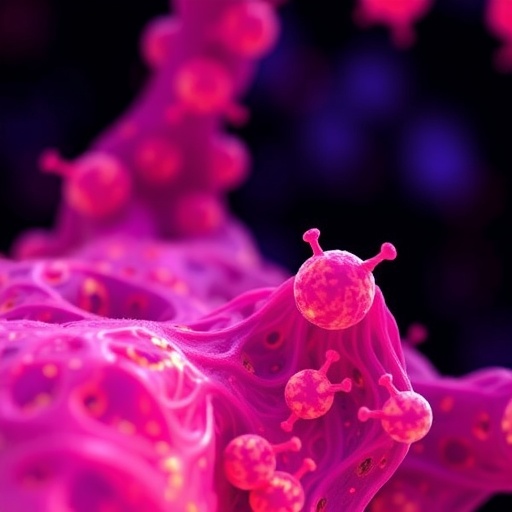In a pioneering advancement in spatial proteomics, researchers have introduced a novel methodology known as Filter-aided expansion proteomics (FAXP). This innovative approach is particularly designed for the high-resolution analysis of formalin-fixed, paraffin-embedded (FFPE) tissues, which have long been challenging to analyze due to their complexities. FAXP combines hydrogel-based tissue expansion with mass spectrometry, resulting in isotropic tissue expansion that maintains the integrity of protein structures while preserving vital spatial features necessary for comprehensive protein analysis.
The FAXP workflow consists of a series of meticulously sequenced steps, each designed to optimize the recovery and analysis of proteins from FFPE samples. The process begins with dewaxing tissue sections, which is essential for the removal of paraffin that can hinder subsequent chemical reactions. Following dewaxing, an in situ protein anchoring step is conducted. This critical stage effectively stabilizes proteins within the tissue matrix, ensuring that they remain accessible for the subsequent steps of the workflow.
Once proteins are anchored, the tissue is embedded in a hydrogel. This embedding not only accommodates the isotropic expansion needed for high-resolution imaging but also plays a crucial role in preserving the structural integrity of the proteins during analysis. Upon successful embedding, the hydrogel-containing tissue undergoes homogenization, a process that disrupts the structural organization of the tissue while ensuring that the proteins remain intact and functional. This homogenization ultimately leads to a more homogeneous sample for mass spectrometry analysis.
After homogenization, the sample is subjected to staining, a vital step that enhances the visibility of specific proteins and cellular structures. This is particularly beneficial in spatial analysis, where the localization of proteins within the tissue context provides invaluable insights into their functions. The hydrogel allows for significant isotropic expansion of the tissue, achieving an impressive linear expansion factor of up to fivefold. This characteristic is particularly advantageous for analyzing samples rich in extracellular matrix components, such as colorectal cancer.
The workflow proceeds with microdissection, where precise isolation of specific tissue regions or even single cells is conducted. This step is exceptionally critical for researchers interested in subcellular spatial proteomics, enabling them to focus on individual cellular components with unparalleled specificity. In combining FAXP with laser capture microdissection, scientists can achieve pinpoint accuracy in their analysis, isolating single cells or subcellular organelles for detailed protein investigation.
The effectiveness of the FAXP method is underscored by its ability to identify an average of 2,368 proteins from a single mouse liver nucleus and 3,312 proteins from a single mouse liver cell shape. These findings were made possible through the use of the advanced Astral mass spectrometer, which is optimized for high-throughput proteomic analysis. The high sensitivity and reproducibility of this method make it an exceptionally powerful tool for researchers examining not just cancerous tissues but a broad spectrum of biological samples, including those from neurodegenerative diseases.
Moreover, FAXP’s compatibility with various tissue types ensures its versatility in research applications. As scientists continue exploring the complexities of cellular microenvironments, FAXP’s robust integration capabilities with other imaging workflows, such as immunostaining, pave the way for spatially resolved proteomic analysis. The ability to correlate protein expression with visual localization opens new doors for understanding the molecular landscapes within tissues.
The entire FAXP workflow is designed to be efficient, taking approximately 27 hours from start to finish. This time-efficient process, combined with the use of commercially available reagents and supplies, makes it accessible to researchers who possess intermediate expertise in tissue processing, microscopy, and proteomics. Its straightforward nature democratizes access to cutting-edge proteomic analysis, inspiring a broader range of scientists to delve into spatial proteomics.
Looking forward, FAXP holds the potential to transform studies centered on cancer heterogeneity and the intricacies of neurodegenerative diseases. By providing a method that can accurately profile protein distributions within complex tissue architectures, researchers are better equipped to uncover the underlying molecular mechanisms of these conditions. In doing so, FAXP not only enhances understanding of specific diseases but also sets the stage for the development of novel therapeutic strategies tailored to individual patient needs.
In summary, the introduction of FAXP as a spatial proteomics technique marks an exciting evolution in the field of proteomics. By marrying hydrogel technology with mass spectrometry, it offers profound insights into the molecular landscapes of FFPE tissues, allowing for detailed analysis at both cellular and subcellular resolutions. As researchers continue to adopt and refine this methodology, the potential for groundbreaking discoveries in biology and medicine expands significantly. The convergence of high-resolution analysis, efficient workflow, and the capability to study diverse tissue types positions FAXP as a critical tool in the ongoing quest to decipher the complexities of life at the molecular level.
Strong advancements like these highlight an essential shift in how we perceive and approach tissue analysis in modern biomedical research. They bring forth a promise of enriched understanding that could lead to breakthroughs in treatment, diagnosis, and the management of various health conditions, paving the way for a future where personalized medicine is the norm rather than the exception.
Subject of Research: Spatial proteomics, FFPE tissues, protein analysis.
Article Title: Filter-aided expansion proteomics for the spatial analysis of single cells and organelles in FFPE tissue samples.
Article References:
Dong, Z., Wu, C., Chen, J. et al. Filter-aided expansion proteomics for the spatial analysis of single cells and organelles in FFPE tissue samples.
Nat Protoc (2025). https://doi.org/10.1038/s41596-025-01256-3
Image Credits: AI Generated
DOI: 10.1038/s41596-025-01256-3
Keywords: Spatial proteomics, FFPE tissue analysis, hydrogel embedding, mass spectrometry, cancer research, neurodegenerative diseases, protein profiling.




